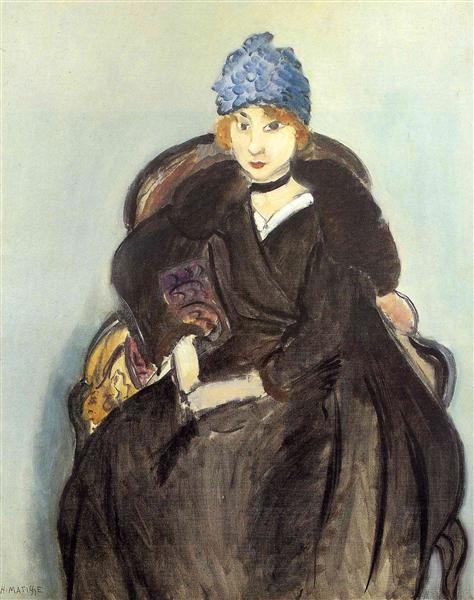Description
The painting "Marguerite Wearing a Hat" from 1918, a masterpiece by Henri Matisse, encapsulates the essence of a stylistic transition in 20th-century art. Matisse, one of the pillars of Fauvism, presents us in this piece with an intimate and delicate vision of Marguerite, his daughter, who appears precisely adorned with a hat, a garment commonly associated with the fashion of the time. Unlike some of the more radical works of the Fauvist period, characterized by their intense colors and exaggerated contours, this painting exhibits a harmonious balance and a softer hue in its palette.
The portrait of Marguerite uses a combination of clear and precise lines to define her forms, very characteristic of Matisse's later style, in which he moves away from the chromatic ferocity of his earlier works to embrace a more contained elegance. In the work, the colors are applied delicately, using a range of soft tones, both in the pinks and beiges present in the face, as well as in the blues and greens that dominate the environment and part of the clothing. These colors create an atmosphere that transcends the merely representational and invites us to a deeper contemplation of Marguerite's character.
Marguerite's hat, an elegant accessory of the time, becomes a central axis of the composition. The attention that Matisse pays to the garment, which seems to have been chosen with care, adds a playful and refined touch to the portrait. The hat is not simply an accessory, but an extension of Marguerite's character, reflecting her status and personality. Her face, finely delineated, emanates an introspection and serenity that transcend the superficiality of the conventional portrait.
A notable aspect of "Marguerite Wearing a Hat" is the spatial composition. Matisse uses a simplified, almost abstract background that keeps the viewer's gaze focused on the main subject without unnecessary distractions. The strokes of the background, suggestive of curtains or a textile setting, provide depth without overloading the canvas. This technique, which allows the figurative elements to stand out more clearly, is consistent with Matisse's quest for purity and economy of means in his art.
The work is not only a testament to Matisse's technical skill but also to his ability to capture the essence of his subjects through apparent simplicity. This painting encapsulates a moment of calm and reflection, while Marguerite, with her serene gaze and adorned hat, presents herself almost as a modern muse.
In the context of Matisse's art, this work is situated in a period of introspection and stylistic consolidation. After the First World War, the artist finds a more serene and less strident path, reflecting the stability sought after the tumultuous early years of the century. In this sense, "Marguerite Wearing a Hat" is a window into the author's evolution, his response to the changes of his time, and his mastery in synthesizing form and color into a unified and deeply human visual experience.
In summary, "Marguerite Wearing a Hat" is not just a portrait, but a composition that emotionally narrates an era and a relationship, allowing those of us who observe to delve into a moment in Marguerite's life and the creative mind of her father, Henri Matisse. This work remains an example of the virtuosity and innovation that define the career of one of the giants of modern art.

